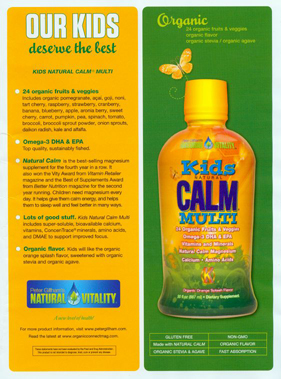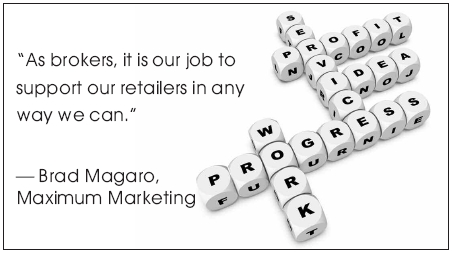A decade ago, the job of a broker was straightforward: to serve as a liaison between stores and distributors—and to sell, sell, sell. There was, in fact, plenty of business to be had. “I’d literally go into a store with a notepad, a pen and a back-up pen. I’d be writing orders at a frenzied pace,” says Bill Weiland, president, CEO and founder of Presence Marketing/Dynamic Presence, South Barrington, IL, who approximates sales once comprised 95% of his job.
Life as a broker is different today. While selling products is still a primary job function, the mix of his or her duties is entirely different. Depending on the region and the representatives, sales may be as much as 75% or as little as 10% of a broker’s job function, Weiland says.
It’s not that brokers are writing less orders than they used to. It’s often quite the opposite; they’re handling more business now than ever before. What has changed is how the broker fits into the natural retail puzzle, and the reasons for the transformation paints an interesting picture of the industry.
The Changing Retail Market
Brushing up your aisles. The natural products industry is maturing in many ways thanks to the large quantity of different items that are now available. Because of this volume, says Weiland, chains (large and small) as well as small buying groups like co-ops are placing orders at the national or regional levels rather than on a store-by-store basis. “It’s a better way to handle your business,” says Weiland.
With a single corporate or regional call, stores can better review category data, product turnover, the rate of return from promotions and other sales data with the help of a good broker who analyzes such information. The larger the pool of data, the more meaningful the trends. In the words of Weiland, it’s like selecting which products you’re going to buy and when with “a little more science.” Small stores, too, can use brokers to break down such sales data so as to better plan out their offerings.
Distributors also have picked up on this new need for ordering advice. Says MaryJo Marks, natural and organic category specialist at United Natural Foods, Inc. (UNFI), Dayville, CT, “Retailers need more category management input within the past few years, and especially the past year.” She suggests that buyers for stores draw on the expertise of good distributors and brokers who have a handle on hot product areas; retailers can use them as tools to help develop strategies for responding to new categories. “With the industry changing, products are becoming more innovative and new categories such as toddler and low-glycemic are emerging. Requests for full-store schematics have increased tremendously as retailers look for quick, efficient ways to update current store categories,” she says.
UNFI, for instance, has a department dedicated to guiding customers in setting up a new store (or implementing a layout). The distributor’s store development team can also “create store layout and design, facilitate equipment orders and provide store schematics on merchandising,” she says.
 Dennis Forkin, vice president of natural specialty for Advantage Sales & Marketing, LLC, Irvine, CA, says his firm is developing dedicated natural teams that “extend beyond our current retail call coverage. These additional merchandisers will have specific training in product merchandising and planogram support.”
Dennis Forkin, vice president of natural specialty for Advantage Sales & Marketing, LLC, Irvine, CA, says his firm is developing dedicated natural teams that “extend beyond our current retail call coverage. These additional merchandisers will have specific training in product merchandising and planogram support.”
Many retailers are in dire need of some sprucing up and paring down of products. Says Brad Magaro, president of Maximum Marketing, Pompano Beach, FL, “Retailers have more of a need for assistance in resets and planogram implementation.”
According to Weiland, category resets are a top request at Presence Marketing/Dynamic Presence. Again, the reason why has to do with the large volume of product availability—which can get retailers into trouble. “Over-SKUing a new section is a common mistake retailers make,” he says. “They get one request or see a cool product and they bring it in, and then shoppers have too many choices of brand.” Having far too many brands in a given category will often result in fewer, rather than additional sales (see this month’s Tip of the Month on page 11). “What’s important is to lock down the brands that are high performers, those that are in demand and new products that are cutting edge and to build a proper banner for all of them,” Weiland suggests.
Here’s where a broker can help. Using sales data, he or she can look at a category, identify some slow-moving items, eliminate products that have too many facings and recommend items to delete. This process can help transform an overwhelming hodgepodge of items into a streamlined, effective collection of offerings.
Narrowing down the search. Again, given the large volume of new and exciting items on the market, it can be tough for retailers to sort through everything. Brokers can be a huge asset on this front. Says Mike Pelton, president of Inner Circle Sales, Glastonbury, CT, “There’s a big push lately from the bigger guys to try to grab new brands and new items to differentiate what they have because everyone seems to be carrying the same things.” These larger players want brokers to sift through the masses and identify what’s new, interesting and worth selling. Given this hat that brokers wear, they also can help small manufacturers that are dying for distribution and market representation (see “How Small Brands Can Make it in the Big World of Natural Products”).
How exactly do brokers and distributors choose new lines to carry? Forkin says his firm keeps an eye on how their portfolio meshes with new options. “We review our current portfolio to see where we have synergies with current clients that will complement the brand’s/client’s growth targets,” he explains.
UNFI’s purchasing team keeps things fresh by attending industry tradeshows to look for new opportunities or line extensions. Marks also says that many products come to UNFI directly from new or existing customers.
How Small Brands Can Make It In the Big World of Natural Products
Small manufacturers: You’ve got a great idea for a natural product. You’ve experimented with the recipe, you know how you’ll produce it and you’ve worked on some packaging prototypes. Now what?
If you’re lost in the big world of natural, you’ve come to the right place. Brokers can help you find your way. Many are excited to be the incubator for new brands. Says Pelton, “I talk to a lot of smaller companies—companies that have really big dreams, are new to the business and might be coming out with the next big product. I tell them what they need to do to succeed; the tough love part.”
For instance, many feel gaining a distributor is a key step. Says Forkin, “Retail distribution truly makes or breaks a brand.”
Pelton advises manufacturers on the best margins to have for clients who want to go through distributors; he also talks with new manufacturers about the infrastructure they should have in place if they want to sell directly to stores. Also, if you’re not a business savvy person, find a partner who is.
Another bit of good advice comes from Magaro of Maximum Marketing: Be prepared to sell your product! The distributor won’t necessarily do it for you. “It is important for newer manufacturers to understand the value of creating the ‘consumer buzz’,” he says, noting that store demos, consumer advertising or social media can work well. “When consumers are asking for products, it is more likely that distributors and brokers will take notice,” Magaro adds.
Choose Your Brokers/Distributors Wisely Here’s some advice from those interviewed for this piece about how to select brokers and distributors that are right for your store: • Make sure they service your store on a regular basis. • Use brokers that present the best new products. • Find representatives who will help train your staff. • Choose those that offer a wide-range of services. • Ensure they are a resource of knowledge. • Look for firms that have good retention rates of brokers. • Don’t forget the basics: great communication with reasonable points of access and quick responsiveness. • Pick brokers that have expertise with store sets and merchandising. • Be sure they share your views on the industry (such as supporting recycling, fair trade and local products). For a list of some natural products brokers and distributors, check out the WholeFoods Annual Source Book (published in May), which also is available at www.wholefoodsmagazine.com. |
Marks of UNFI agrees, and offers this list of advice:
- Speak about whether any proceeds from product sales will be given to a special cause.
- Provide active demonstrations. “Let the buyer see it in action,” she says.
- Provide a list of vendors and/or distributors that already carry your product, if applicable.
- To get the ball rolling, be willing to offer initial support such as a percentage off, free fill, demo opportunities and the like. “The faster you start selling, the better,” says Marks.
Last, it’s extremely important for your product to be unique in some way. Weiland looks for products in good, underserved categories or those that bring some clear innovation to the table in a crowded category. “They must have clear points of differentiation, whether it’s a value play or unique attributes of the product,” he says. To put it in perspective, his company only picks up about 3.5% of the brands that approach the firm. “The days of coming to market by putting a bag of granola on the shelf and building a business based off the product turns without an infusion of capital are all but gone,” he says.
Adds Pelton, “Every time I go to a distributor, they are screening out a lot of these smaller brands for the retail buyers they deal with. The first thing they ask is what makes the brand different. It’s got to have a unique spin; a special property they can advertise.”
Similarly, he also suggests keeping the line focused because most distributors don’t pick up a whole line at once. “They pick up the key or top item,” he says. And, if you do launch a whole line, “there’s a lot of pressure to keep only the SKUs that are selling,” says Pelton. His answer: “Focus on the best SKUs for distribution. And, make sure they’re supported.” Then, if the product sells well, they’re more likely to add the other items.
The reverse can be devastating: “If you put out 10 and only two are good, distributors are going to be hesitant to pick up new items because they’ll have to discontinue the old ones,” says Pelton. It should be noted, however, that in today’s competitive market, even getting line extensions is no guarantee.
Some words of caution with respect to overextending one’s growth. “We’re seeing a lot of brands just go for it. They get several points of distribution and they don’t have a way to support it,” says Weiland. “So now, more than ever, we’re advocating test markets.” Instead of a national roll out, start regional and then build up from there—unless you can make the financial and staffing commitment to step up to the plate on a national level. WF
Published in WholeFoods Magazine, June 2010











